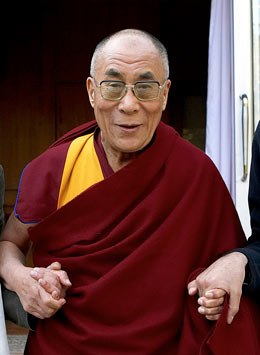
Ocean of Compassion
The Fourteenth Dalai Lama
Born: 1935 Residence: Dharamsala, India Birth Name: Tenzin Gyatso
Dalai Lama: “teacher whose wisdom is as great as the ocean”; an honorary title bestowed by the Mongolian prince Altan Khan on the third head of the Gelukpa school in 1578. This close connection with Mongolia brought the school of Tsongkhapa into a position of political preeminence, which with the fifth dalai lama (1617-82) was consolidated into rulership over all of Tibet. Since this time, the Dalai Lama has been regarded as an incarnation of Avalokiteshvara, and the Panchen Lama has been venerated as his spiritual representative. Each Dalai Lama is considered a reincarnation (tulku) of the preceding Dalai Lamas. The Dalai Lamas not only fulfilled their role as heads of state. Among them are also great scholars and poets filled with joie de vivre, like the sixth Dalai Lama. The fourteenth Dalai
Lama, in exile since 1959, combines in his person a spiritual and political authority that is still binding for the Tibetan people.
The individual Dalai Lamas are:
1. Dalai Lama Gendun Drub (1391-1475) 2. Dalai Lama Gendun Gyatso (1475-1542) 3. Dalai Lama Sonam Gyatso (1543-1588) 4. Dalai Lama Yonten Gyatso (1589-1617) 5. Dalai Lama Losang Gyatso (1617-1682) 6. Dalai Lama Jamyang Gyatso (1683-1706) 7. Dalai Lama Kelsang Gyatso (1708-1757) 8. Dalai Lama Jampel Gyatso (1758-1804) 9. Dalai Lama Lungtog Gyatso (1806-1815) 10. Dalai Lama Tsultrim Gyatso (1816-1837) 11. Dalai Lama Kednib Gyatso (1838-1856) 12. Dalai Lama Trinie Gyatso (1856-1875) 13. Dalai Lama Tubten Gyatso (1876-1933) 14. Dalai Lama Tenzin Gyatso (born 1935)
Believed like his predecessors to be the incarnation of the Bodhisattva Avalokiteshvara, the 14th Dalai Lama, Tenzin Gyatso (1935 – ) was installed in 1940. In 1959, following a Tibetan revolt against Chinese rule, he fled into exile. He has travelled widely, pleading the Tibetan cause. Recipient of the 1989 Nobel Peace Prize, he wrote an autobiography, Freedom in Exile (1990).
Birth and Family Life
The Dalai Lama was born on 6 July 1935, named Lhamo Thondup, to a poor family in Taktser in the province of Amdo. The name, Lhamo Thondup, literally means ‘Wish-Fulfilling Goddess’. Taktser (Roaring Tiger) was a small and poor settlement which stood on a hill overlooking a broad valley. “Its pastures had not been settled or farmed for long, only grazed by nomads. The reason for this was the unpredictability of the weather in that area,” writes the Dalai Lama in his autobiography
Freedom in Exile. “During my early childhood, my family was one of twenty or so making a precarious living from the land there.”
The Dalai Lama’s parents were small farmers who mostly grew barley, buckwheat and potatoes. The Dalai Lama’s father was a man of medium height with a very quick temper. “I remember pulling at his moustache once and being hit hard for my trouble,” recalls the Dalai Lama. “Yet he was a kind man too and he never bore any grudges.” The Dalai Lama recalls his mother as “undoubtedly one of the kindest people I have ever known.”

The Dalai Lama as a child with his family
The Dalai Lama had an elder sister and three elder brothers at that time. Tsering Dolma, the eldest child, was eighteen years older than the Dalai Lama. “At the time of my birth she helped my mother run the house and acted as my midwife. When she delivered me, she noticed that one of my eyes was not properly open. Without hesitation she put her thumb on the reluctant lid and forced it wide fortunately without any ill effect,” the Dalai Lama writes. The Dalai Lama’s three elder brothers were Thupten Jigme Norbu – the eldest, who had already been recognised as the reincarnation of a high lama, Taktser Rinpoche – Gyalo Thondup and Lobsang Samten. “Of course, no one had any idea that I might be anything other than an ordinary baby. It was almost unthinkable that more than one tulku (reincarnation) could be born into the same family and certainly unthinkable to my parents that I would be proclaimed Dalai Lama,” His Holiness writes.
Though the remarkable recovery made by the Dalai Lama’s father from his critical illness at the time of his son’s birth was auspicious, it was not taken to be of great significance. “I myself likewise had no particular intimation of what lay ahead. My earliest memories are very ordinary.” The Dalai Lama recollects his earliest memory, among others, of observing a group of children fighting and running to join in with the weaker side. “One thing that I remember enjoying particularly as a very young boy was going into the hen coop to collect the eggs with my mother and then staying behind. I liked to sit in the hens nest and make clucking noises. Another favourite occupation of mine as an infant was to pack things in a bag as if I was about to go on a long journey. “I’m going to
Lhasa, I’m going to Lhasa,” I would say. This, coupled with my insistence that I be allowed always to sit at the head of the table, was later said to be an indication that I must have known that I was destined for greater things.”
Tulku, the Reincarnation
The Dalai Lama is held to be the reincarnation of each of the previous thirteen Dalai Lamas of Tibet (the first having been born in 1351 AD), who are in turn considered to be manifestations of Avalokiteshvara or Chenrezig, Bodhisattva of Compassion, holder of the White Lotus. The Dalai Lama is also believed to be a manifestation of Chenrezig, in fact the seventy-fourth in a lineage that can be traced back to a Brahmin boy who lived in the time of Buddha Sakyamuni. “I am often asked whether I truly believe this. The answer is not simple to give. But as a fifty-six year old, when I consider my experience during this present life, and given my Buddhist beliefs, I have no difficulty accepting that I am spiritually connected both to the thirteen previous Dalai Lamas, to Chenrezig
and to the Buddha himself.”
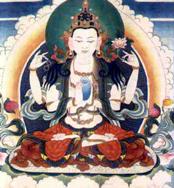
Chenrezig,
Bodhisattva of Comapassion,
holder of the White Lotus
When Lhamo Thondup was barely three years old, a search party that had been sent out by the Tibetan government to find the new incarnation of the Dalai Lama arrived at Kumbum monastery. It had been led there by a number of signs. One of these concerned the embalmed body of his predecessor, Thupten Gyatso, the Thirteenth Dalai Lama, who had died aged fifty-seven in 1933. During the period of the body sitting in state, the head was discovered to have turned from facing south to north-east. Shortly after that the Regent, himself a senior lama, had a vision. Looking into the waters of the sacred lake, Lhamoi Lhatso, in southern Tibet, he clearly saw the Tibetan letters Ah, Ka and Ma float into view. These were followed by the image of a three-storeyed monastery with a turquoise and gold roof and a
path running from it to a hill. Finally, he saw a small house with strangely-shaped guttering.
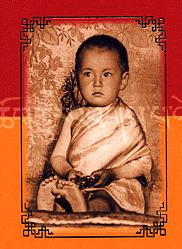
Family Portrait of the Dalai Lama
as a three year old child
He was sure that the letter Ah referred to Amdo, the north-eastern province, so it was there that the search party was sent. By the time they reached Kumbum, the members of the search party felt that they were on the right track. It seemed likely that if the letter Ah referred to Amdo, then Ka must
indicate the monastery at Kumbum which was indeed three-storeyed and turquoise-roofed. They now only needed to locate a hill and a house with peculiar guttering. So they began to search the neighbouring villages. When they saw the gnarled branches of juniper wood on the roof of the Dalai Lama’s parents’ house, they were certain that the new Dalai Lama would not be far away. Nevertheless, rather than reveal the purpose of their visit, the group asked only to stay the night. The leader of the party, Kewtsang Rinpoche, then pretended to be a servant and spent much of the evening observing and playing with the youngest child in the house.
The child recognised him and called out, “Sera lama, Sera lama”. Sera was Kewtsang Rinpoche’s monastery. Next day they left only to return a few days later as a formal deputation. This time they brought with them a number of things that had belonged to the Thirteenth Dalai Lama, together with several similar items that did not. In every case, the infant correctly identified those belonging to the Thirteenth Dalai Lama saying, “It’s mine. It’s mine.” This more or less convinced the
search party that they had found the new incarnation. It was not long before the boy from Taktser was acknowledged to be the new Dalai Lama.
Exile to India, Travels
<>In 1950 the Chinese ‘liberation’ of Tibet commenced. In 1955 the Dalai Lama visited Peking and had conversations with Chairman Mao Zedong. He later returned to Tibet, and in 1956 attended the Buddha Jayanthi (birthday of the Buddha) celebrations in India with the assistance of Pandit Nehru (Prime Minister). In 1959, he made a daring flight to freedom and exile to India. Immediately prior to this event, an astrologer told the Dalai Lama that the Jewel in the Lotus would shine in the West. This seems to have been a most astute prediction that has been borne out by events since that flight to freedom.
In his autobiography, Freedom in Exile, the Dalai Lama comments on viewing the victims of war, and this account evokes the compassion residing within him:
After paying my final respects to the late Prime Minister, I returned to Dharamsala, but no before visiting some of the hospitals in Delhi containing casualties from the war. Most of those that I saw were Officers. Many were in great pain and enduring terrible hardship. As I walked between rows of beds, amongst sobbing family members of the wounded I thought to myself that this was the only real result of war: tremendous human suffering. Anything else that might arise from conflict could just be as easily brought about by peaceful means. It was small consolation to realise that the people in this hospital were being well looked after—many of those who had been caught up in the struggle would not have had the benefit of such good facilities.
While in exile, the Dalai Lama called a meeting of all heads of the different Tibetan Buddhist traditions together with representatives of the Bon religion. Discussion cantered on the common difficulties experienced and examined strategies to overcome difficulty in order to preserve and propagate different aspects of Tibetan Buddhist culture. “At the end of several days, I was satisfied that, if we could only provide ourselves the the right facilities, our religion would survive.”
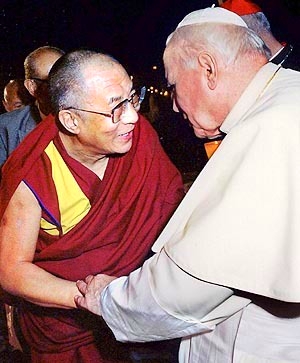
The Dalai Lama with Pope John Paul II
The Dalai Lama made his first journey outside India during the autumn of 1967, when he visited Japan and Thailand. In 1978, he made his first trip to Europe and
Scandinavia. He also visited Switzerland, where many orphaned children had been accepted by the Swiss Government. His first visit to the US came in 1979. In 1982 he visited Rome and met with Pope John Paul II. Due so many visits to the West the Dalai Lama has been able to make the following observations:
Overall I have found much that is impressive about Western society. In particular, I admire its energy and creativity and hunger for knowledge. On the other hand, a number of things about the Western Way of life cause me concern. One thing I have noticed is the inclination for people to think in terms of “black and white”, and “either-or”, which ignores the fact of interdependence and relativity. They have a tendency to lose sight of the grey areas which inevitably exist between two points of view.
In responding to invitations made by others the Dalai Lama is often asked to address groups of people. He tells, “When this happens, my approach is threefold. Firstly, as a human being, I talk about what I have termed Universal Responsibility. By this I mean the responsibility that we all have for each other and for all sentient beings and also for all Nature.”

The Dalai Lama with industrialists
“Secondly, as a Buddhist Monk, I try to contribute what I can towards better harmony and understanding between different religions. As I have said, it is my firm belief that all religions aim at making people better human beings and that despite philosophical differences, some of them fundamental, they all aim at helping humanity to find happiness. This does not mean that I advocate any sort of world religion or ‘super religion’. Rather, I look on religion as medicine. For different complaints, doctors will prescribe different remedies. Therefore, because not everyone’s spiritual illness is the same, different spiritual medicines are required.
“Finally, as a Tibetan and furthermore as the Dalai Lama, I talk about my own country, people and culture whenever anyone shows interest in these matters. However, although I am greatly encouraged when people do show concern for my homeland and my suffering fellow countrymen and women in occupied Tibet, and although it gives fuel to my determination to continue the fight for Justice, I do not consider those who support our cause to be pro Tibet. Instead, I consider them to be pro-Justice.”
The Nobel Prize
On 10 December 1989, Tenzin Gyatso, 14th Dalai Lama, was awarded the Nobel Prize for Peace. The following excerpts are taken from the Nobel Peace Prize, Acceptance Speech, Oslo, December 10, 1989.
No matter what part of the world we come from, we are all basically the same human beings. We all seek happiness and try to avoid suffering. We have the same basic human needs and concerns. All of us human beings want freedom and the right to determine our own destiny as individuals and as peoples. That is human nature. The great changes that are taking place everywhere in the world, from Eastern Europe to Africa, are a clear indication of this.
As a Buddhist monk, my concern extends to all members of the human family and, indeed, to all sentient beings who suffer. I believe all suffering is caused by ignorance. People inflict pain on others in the selfish pursuit of their happiness or satisfaction. Yet true happiness comes from a sense of inner peace and contentment, which in turn must be achieved through the cultivation of altruism, of love and compassion and elimination of ignorance, selfishness and greed.
With the ever-growing impact of science on our lives, religion and spirituality have a greater role to play by reminding us of our humanity. There is no contradiction between the two. Each gives us valuable insights into the other. Both science and the teachings of the Buddha tell us of the fundamental unity of all things. This understanding is crucial if we are to take positive and decisive action on the pressing global concern with the environment. I believe all religions pursue the same goals, that of cultivating human goodness and bringing happiness to all human beings. Though the means might appear different the ends are the same. Nobel Peace
Prize, Acceptance Speech, Oslo, December 10,
1989
In Exile, the Dalai Lama has slowly become recognised throughout the Western World as a significant icon of brotherly love and peace. He has tirelessly responded to requests for visits and interviews, and is heralded as a World Teacher for peace and non violence. He is a peerless example of character and integrity, always walking his talk. He is both a spiritual and temporal figure of world renown, and a most significant teacher of world peace due his unwavering policy of non violence.
The Jewel in the Lotus
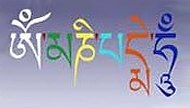
Om Mane Padme Hum characters in Tibetan script;
meaning, The Jewel in the Lotus
the famous mantra of Chenrezig, written in Tibetan script. It is said that all the teachings of the Buddha are contained in this mantra. Tibetan Buddhists believe that saying the mantra (prayer), out loud or silently to oneself, invokes his powerful benevolent attention. Viewing the written form of the mantra is said to have the same effect, and it is often carved into stones, placed where people can see them.
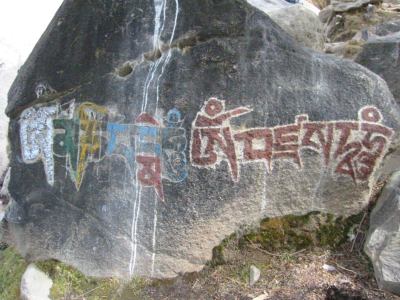
Om Mane Padme Hum characters in Tibetan script carved on a rock outside the Potsala Palace. source,
en.wikipedia.org
H.H. the 14th Dalai Lama’s definition
“It is very good to recite the mantra Om mani padme hum, but while you are doing it, you should be thinking on its meaning, for the meaning of the six syllables is great and vast… The first, Om […] symbolizes the practitioner’s impure body, speech, and mind; it also symbolizes the pure exalted body, speech, and mind of a Buddha[…]”
“The path is indicated by the next four syllables. Mani, meaning jewel, symbolizes the factors of method: (the) altruistic intention to become enlightened, compassion, and love.[…]”
“The two syllables, padme, meaning lotus, symbolize wisdom […]”
“Purity must be achieved by an indivisible unity of method and wisdom, symbolized by the final syllable hum, which indicates indivisibility[…]” “Thus the six syllables, om mani padme hum, mean that in dependence on the practice of a path which is an indivisible union of method and wisdom, you can transform your impure body, speech, and mind into the pure exalted body, speech, and mind of a Buddha[…]”
source: en.wikipedia.org
![]()

